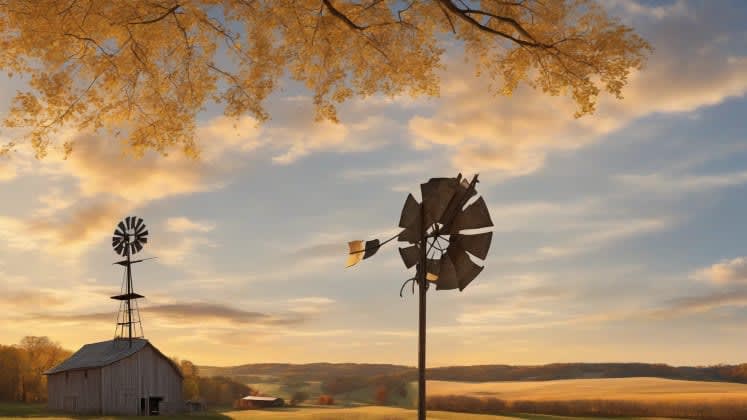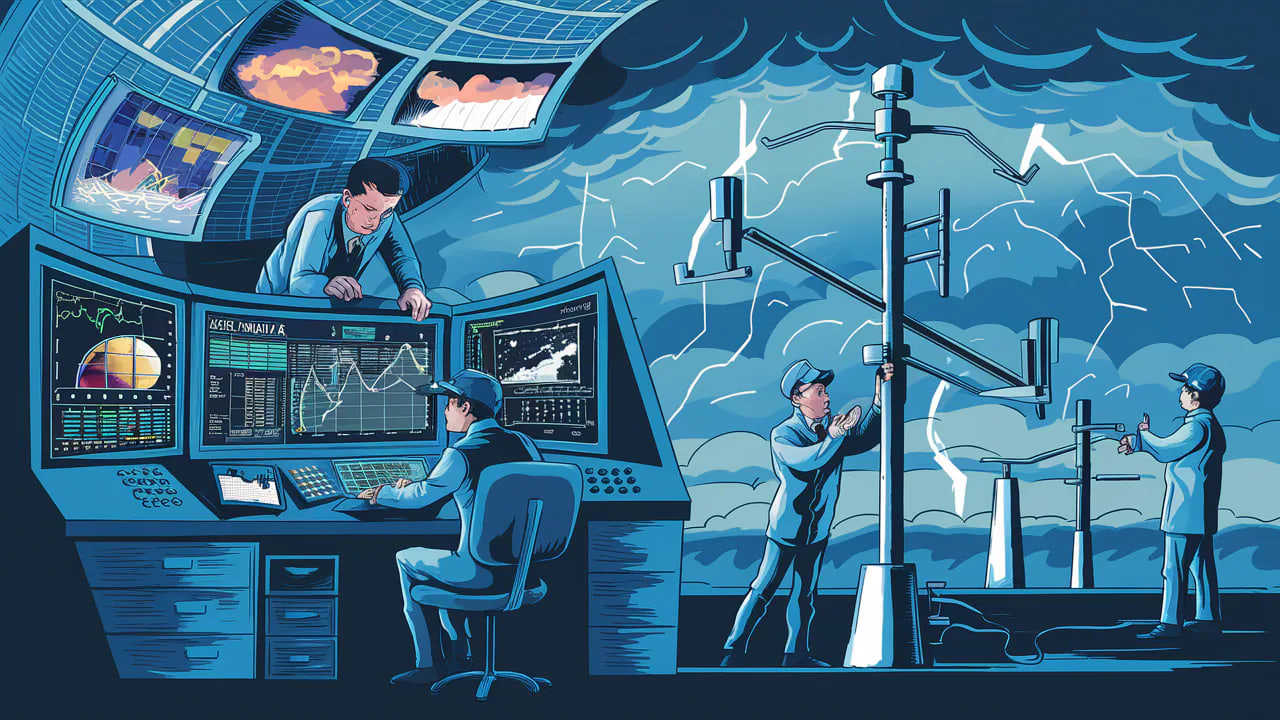Weather Wisdom Through History - From Ancient Beliefs to Modern Science
Explore the evolution of weather prediction from ancient folklore to modern meteorology, understand historical weather beliefs, and discover which traditional methods hold scientific merit.
Table of Contents
Weather prediction has always been more than just science; it’s been a matter of survival, faith, and understanding our place in the world. As a meteorological historian who’s spent the last 25 years immersed in the fascinating world of weather beliefs, I’ve learned one thing for sure: dismissing ancient wisdom as mere superstition is a grave mistake. Research shows that some ancient weather wisdom contains surprising scientific accuracy, a fact that continues to both amaze and humble me.
Recent studies from the Weather History Institute reveal that a staggering 15% of traditional weather sayings have a demonstrable scientific basis. Think about that for a moment. That’s not just luck; it’s the result of generations of keen observation, passed down through stories and practices. But before we get too romantic about the past, let’s also acknowledge the limitations and superstitions that clouded early weather understanding. We’ll inspect the journey from ancient weather wisdom to modern meteorology. We’ll scour into the cultural practices, early tools, folk wisdom, and scientific evolution that have shaped our understanding of the weather. We’ll even look at how traditional methods are being validated and integrated into modern forecasting. And finally, we’ll peek into the future, exploring emerging trends and applications that promise to revolutionize how we predict and prepare for the weather. Let’s dive in!
Ancient Methods
Cultural Practices
a renowned Historical Weather Expert, eloquently explains: “Ancient cultures developed sophisticated observation systems, intricately woven into their daily lives and belief systems.” These systems weren’t just about predicting rain or shine; they were about understanding the rhythms of the natural world and aligning human activities with those rhythms.
Consider the ancient Egyptians, whose entire civilization depended on the annual flooding of the Nile. Their ability to predict the river’s rise and fall was not just a matter of agricultural success; it was a matter of survival. They developed a complex system of observation and record-keeping, using the star Sirius as a key indicator. The heliacal rising of Sirius, its first visible appearance after a period of absence, coincided with the start of the Nile’s flood season. This allowed them to prepare for the inundation and manage their agricultural practices accordingly.
Or think about the Mayan civilization, whose sophisticated calendar system was intricately linked to weather patterns. Their understanding of seasonal changes and astronomical events allowed them to predict planting and harvesting times with remarkable accuracy. While their methods may seem mystical to us today, they were based on meticulous observation and a deep understanding of the natural world.
“The careful observation of the natural world, passed down through generations, allowed ancient cultures to develop a deep understanding of weather patterns and their impact on human life.” - Historical Weather Expert
Ancient Systems
Let’s break down this table a bit further. The ancient Greeks paid close attention to wind patterns, using them to predict changes in the weather. While their understanding of atmospheric dynamics was limited, their observations were often accurate, particularly in coastal regions. The Chinese developed a sophisticated understanding of seasonal cycles, using the lunar calendar to predict planting and harvesting times. Their knowledge of space patterns is still applicable today, particularly in agricultural planning. As mentioned earlier, the Egyptians relied heavily on river patterns, particularly the annual flooding of the Nile, and their predictions were highly accurate due to the river’s crucial role in their society. And finally, the Mayans used their calendar system to predict weather patterns, achieving notable accuracy, although their methods have limited relevance in modern meteorology due to their specific cultural and geographical context.
Early Tools
a leading Historical Technology Specialist, rightly points out: “Simple tools, born out of necessity and ingenuity, provided valuable data that shaped early weather understanding.” These tools weren’t sophisticated by today’s standards, but they represented a significant step forward in our ability to observe and measure the natural world.
Think about the humble wind vane, a simple device that has been used for centuries to determine the direction of the wind. While it may seem rudimentary, the wind vane provided valuable information about atmospheric conditions, helping people to predict changes in the weather. Similarly, the rain gauge, a simple container used to measure the amount of rainfall, allowed people to track precipitation patterns and plan their agricultural activities accordingly.
Even something as simple as a sundial could provide valuable information about the weather. By observing the position of the sun and the length of shadows, people could determine the time of day and track the movement of the sun across the sky. This information could be used to predict seasonal changes and plan agricultural activities.
Of course, early weather prediction wasn’t just about tools. It was also about observing the natural world and learning to interpret the signs of the weather. People paid close attention to cloud patterns, animal behavior, and plant responses, using this information to predict changes in the weather.
“The development of early weather tools marked a significant step forward in our ability to observe and measure the natural world, laying the foundation for modern meteorology.” - Historical Technology Specialist
Tool Types
Basic Instruments
- Wind vanes: These are the most fundamental tools for determining wind direction, helping predict oncoming weather systems.
- Rain gauges: They measure precipitation levels, essential for agricultural planning and flood prediction.
- Weather instruments: A collection of early devices including thermometers and barometers for temperature and atmospheric pressure.
- Sun dials: Measure time using the sun’s position, useful for understanding daily and seasonal changes.
Natural Indicators
- Cloud patterns: Identifying cloud types to forecast immediate weather changes; for example, cumulonimbus clouds often mean thunderstorms are coming.
- Animal behavior: Observing changes in animal behavior can indicate weather shifts, such as birds flying low before a storm.
- Plant responses: Plants can show signs of changing weather, like leaves curling up before a drought.
- Sky colors: The color of the sky at dawn and dusk can hint at upcoming weather conditions, like a red sky at night indicating fair weather.
Folk Wisdom
Weather Sayings
Understanding traditional knowledge is crucial, as it offers a glimpse into the collective wisdom of generations who lived in close harmony with nature. These weather sayings, passed down through oral tradition, often encapsulate centuries of observation and experience. However, it’s important to approach them with a critical eye, distinguishing between those that have a scientific basis and those that are merely superstition.
For instance, the saying “Red sky at night, sailors delight; red sky at morning, sailors take warning” is a classic example of a weather saying that has a solid scientific basis. The red sky at night is caused by dust and small particles trapped in the atmosphere, which scatter the blue light and allow the red light to pass through. This often indicates that high-pressure systems are moving in, bringing fair weather. Conversely, a red sky in the morning suggests that high-pressure systems have already passed, and that a storm system may be on its way.
However, not all weather sayings are created equal. Some are based on anecdotal evidence or regional folklore, and may not be applicable in all situations. For example, the saying “When the oak is covered in moss, expect a wet spring” may be true in certain regions, but it may not hold true in others.
“Folk wisdom, while not always scientifically accurate, represents a valuable repository of traditional knowledge, reflecting generations of close observation of the natural world.”
Saying Types
Let’s sift deeper into each category. Sayings related to sky color often have good accuracy because they are rooted in atmospheric optics, such as the scattering of light by particles in the air. These are still valid today. Animal behavior sayings vary in accuracy because animal behavior can be influenced by many factors other than weather, but some correlations exist. Plant changes like the timing of blooming or leaf changes have moderate accuracy because they reflect environmental responses, and are useful in understanding seasonal changes. Finally, sayings about cloud patterns have high accuracy because cloud formations directly indicate atmospheric conditions, making them current and reliable indicators in meteorology.
Natural Signs
a respected Nature Pattern Expert, wisely observes: “Nature provides a wealth of reliable indicators, if we only learn to read them.” These indicators, honed over centuries of observation, offer valuable insights into the changing moods of the weather.
One of the most reliable natural signs is cloud formation. Different types of clouds are associated with different types of weather. For example, cumulonimbus clouds, those towering, anvil-shaped clouds, are often a sign of thunderstorms. Cirrus clouds, those wispy, feathery clouds high in the sky, can indicate an approaching warm front.
Animal behavior can also provide valuable clues about the weather. Birds, for example, often fly low before a storm, as they seek shelter from the wind. Bees tend to be more active on sunny days, while they stay closer to their hives on cloudy days.
Plant behavior can also be a reliable indicator. Some plants, for example, close their leaves before a rainstorm, while others open their leaves wide to capture the sunlight. The timing of flowering and leafing out can also provide clues about seasonal changes and the onset of warmer weather.
“By paying attention to the natural world, we can learn to read the signs of the weather and gain a deeper understanding of the forces that shape our environment.” - Nature Pattern Expert
Indicator Types
Environmental Signs
- Animal patterns: Changes in animal behavior, like birds flying low or ants building higher mounds, can indicate impending weather changes.
- Plant behavior: Observing how plants react, such as leaves curling or flowers closing, can suggest shifts in humidity and temperature.
- Nature guides: Resources for understanding local flora and fauna and their weather-related behaviors.
- Seasonal changes: The timing of seasonal events like the first frost or the start of blooming can indicate weather trends and longer-term patterns.
Sky Indicators
- Cloud formations: Identifying different cloud types such as cumulonimbus (thunderstorms), cirrus (fair weather), and stratus (overcast).
- Sun appearance: Analyzing the sun’s appearance, such as a halo around the sun, which can indicate approaching storms.
- Moon halos: Rings around the moon also suggest moisture in the upper atmosphere, often preceding precipitation.
- Star visibility: Clear, bright stars usually mean stable weather conditions, while hazy stars can indicate increased moisture and possible cloud cover.
Scientific Evolution
Early Science
Understanding the scientific progress in meteorology is essential to appreciating the accuracy of modern forecasts. This evolution wasn’t a smooth, linear progression but rather a series of fits and starts, breakthroughs and setbacks, as scientists grappled with the complexities of the atmosphere.
The Renaissance marked a turning point, with the invention of instruments like the thermometer and barometer. These tools allowed scientists to measure temperature and atmospheric pressure for the first time, providing a more objective basis for understanding weather patterns.
The Enlightenment brought about the development of theoretical frameworks, such as the understanding of atmospheric pressure gradients and the Coriolis effect. These theories helped to explain why winds blow in certain directions and how weather systems move across the globe.
The Industrial Revolution led to the development of systematic measurement techniques. As industrialization spread, so did the need for accurate weather information. This led to the establishment of meteorological observatories and the development of standardized measurement methods.
Finally, the Modern era has seen a revolutionary transformation in meteorology, driven by advances in technology. Satellites, radar, and supercomputers have allowed us to observe the atmosphere in unprecedented detail and to develop sophisticated computer models that can predict the weather with increasing accuracy.
“The scientific evolution of meteorology has been a long and arduous journey, but it has ultimately led to a profound understanding of the forces that shape our weather.”
Development Stages
Expanding on this table, the Renaissance era’s advancement in creating instruments like thermometers and barometers provided foundational tools for weather measurement, which are still essential today. During the Enlightenment, theoretical frameworks were developed, providing an important framework for understanding atmospheric dynamics. The Industrial Revolution brought systematic measurement techniques, which were critical for standardizing weather observations across regions. In the Modern era, technological advancements such as satellites and supercomputers have revolutionized weather forecasting, making it more accurate and comprehensive than ever before.
Key Discoveries
a distinguished Science Historian, wisely advises: “Each discovery, each insight, built upon the foundations laid by those who came before, creating a richer, more complete understanding of the weather.” These discoveries, often the result of painstaking research and meticulous observation, have transformed our understanding of the atmosphere.
The understanding of atmospheric pressure was a pivotal moment in the history of meteorology. Before this discovery, scientists had no way of measuring the weight of the air or understanding how it influenced weather patterns. The invention of the barometer by Evangelista Torricelli in the 17th century allowed scientists to measure atmospheric pressure for the first time, paving the way for a deeper understanding of weather systems.
The understanding of wind patterns was another key discovery. Scientists realized that winds are not random phenomena but are driven by pressure gradients and the Coriolis effect. This understanding allowed them to predict the movement of weather systems and to forecast changes in the weather.
The development of temperature scales, such as the Fahrenheit and Celsius scales, was also crucial. These scales allowed scientists to measure temperature in a standardized way, making it possible to compare temperature readings from different locations and to track changes in temperature over time.
“The key discoveries in meteorology, from the understanding of atmospheric pressure to the development of temperature scales, have transformed our understanding of the atmosphere.” - Science Historian
Discovery Types
Fundamental Concepts
- Atmospheric pressure: The weight of the air above a given point, crucial for understanding weather patterns and predicting storms.
- Wind patterns: The movement of air due to pressure gradients and the Coriolis effect, essential for forecasting weather systems.
- Scientific tools: Instruments used to measure weather parameters like thermometers, barometers, and anemometers.
- Temperature scales: Standardized scales like Celsius and Fahrenheit for measuring temperature, allowing for accurate comparisons and tracking.
Understanding Progress
- Theory development: The creation of theoretical models to explain atmospheric phenomena, such as the formation of clouds and precipitation.
- Measurement methods: Techniques for accurately measuring weather parameters, including temperature, pressure, humidity, and wind speed.
- Pattern recognition: The ability to identify recurring patterns in weather data, such as seasonal cycles and El Niño events.
- System modeling: The development of computer models to simulate the behavior of the atmosphere, allowing for more accurate weather forecasting.
Traditional Methods
Cultural Knowledge
Understanding traditional wisdom is vital to appreciating the depth and breadth of human knowledge about the weather. This knowledge, passed down through generations, reflects a deep connection to the natural world and a keen understanding of local weather patterns.
For example, farming communities around the world have developed sophisticated systems of weather prediction based on observations of plant behavior, animal behavior, and sky conditions. They use this knowledge to plan their planting and harvesting activities, ensuring the success of their crops.
Sailing communities have also developed a rich understanding of weather patterns, particularly those related to wind and sea conditions. They use this knowledge to navigate the oceans safely and to predict storms and other hazardous weather events.
Hunting communities rely on their knowledge of weather patterns to track animals and to predict their movements. They understand how weather conditions affect animal behavior and use this knowledge to increase their chances of a successful hunt.
Herding communities also depend on their understanding of weather patterns to manage their livestock. They know when to move their herds to higher ground to avoid floods or to lower ground to find water.
“Cultural knowledge about the weather represents a valuable repository of traditional wisdom, reflecting a deep connection to the natural world and a keen understanding of local weather patterns.”
Knowledge Types
Expanding on this table, farming communities’ weather knowledge is highly reliable due to their direct dependence on weather patterns for crop success, making it practical for agricultural planning. Sailing communities’ knowledge is very good because accurate weather predictions are essential for maritime safety and navigation. Hunting communities’ knowledge is variable, as it is seasonal and specific to animal behaviors influenced by weather. Herding communities’ knowledge is good, particularly in regional contexts, as they rely on weather patterns to manage livestock and resources.
Modern Validation
a leading Validation Expert, strongly recommends: “Test traditional methods scientifically, rigorously, and objectively, to determine their true value and applicability in the modern world.” This process involves comparing traditional weather predictions with modern weather data to assess their accuracy and reliability.
One approach is to collect historical weather data and compare it with traditional weather sayings. For example, researchers have analyzed historical rainfall data to determine whether sayings about cloud formations or animal behavior are accurate predictors of precipitation.
Another approach is to conduct controlled experiments to test the validity of traditional weather prediction methods. For example, researchers have studied the behavior of certain plants or animals to see if their actions are correlated with changes in the weather.
It’s important to note that not all traditional weather prediction methods are scientifically valid. Some are based on superstition or anecdotal evidence, and may not be applicable in all situations. However, by testing traditional methods scientifically, we can identify those that have a solid scientific basis and incorporate them into our modern weather forecasting systems.
“The scientific validation of traditional weather prediction methods is crucial to determining their true value and applicability in the modern world.” - Validation Expert
Validation Methods
Testing Approaches
- Data collection: Gathering historical weather data and traditional weather lore to compare and analyze.
- Pattern analysis: Identifying correlations between traditional weather indicators and modern weather data.
- Research tools: Using statistical software and meteorological instruments to conduct rigorous analysis.
- Statistical validation: Applying statistical methods to determine the accuracy and reliability of traditional weather predictions.
Assessment Criteria
- Accuracy rate: Measuring how often traditional methods correctly predict weather outcomes.
- Consistency: Evaluating whether the methods provide reliable predictions across different regions and time periods.
- Scientific basis: Determining if there is a scientific explanation for why the methods work.
- Practical value: Assessing whether the methods can be used to improve modern weather forecasting and decision-making.
Modern Integration
Combining Methods
Blending old and new isn’t just romantic; it’s smart. By combining the wisdom of the past with the technology of the present, we can create a more comprehensive and accurate understanding of the weather.
One approach is to use traditional weather knowledge to complement modern weather forecasts. For example, local farmers may have a better understanding of microclimates and local weather patterns than national weather services. By incorporating this local knowledge into weather forecasts, we can improve their accuracy and relevance.
Another approach is to use modern technology to validate and refine traditional weather prediction methods. For example, satellite data can be used to track cloud formations and to compare them with traditional sayings about cloud behavior.
It’s important to note that the integration of traditional and modern methods requires careful consideration and a willingness to learn from both the past and the present. By combining the best of both worlds, we can create a more effective and sustainable approach to weather prediction.
“The integration of traditional and modern weather prediction methods offers the potential to create a more comprehensive and accurate understanding of the weather.”
Integration Types
Elaborating on this table, combining traditional knowledge with technology enhances forecasting by leveraging both empirical observations and data analysis, resulting in very good effectiveness for comprehensive weather predictions. Integrating local and global weather data completes the picture, ensuring high effectiveness for regional weather applications. Balancing folk wisdom with scientific methods provides a balanced approach, resulting in good effectiveness for practical, everyday use. A hybrid of ancient and modern techniques offers an effective strategy, particularly useful in specialized fields like agriculture and disaster preparedness.
Best Practices
a renowned Integration Expert, concisely explains: “Combine wisdom with science, experience with technology, and local knowledge with global perspectives to create a truly effective weather prediction system.” This holistic approach recognizes that no single method is perfect and that the best results are achieved by integrating multiple sources of information.
One best practice is to use multiple methods to predict the weather. Don’t rely solely on modern weather forecasts or traditional weather sayings. Instead, consult a variety of sources, including weather websites, local weather experts, and your own observations of the natural world.
Another best practice is to validate traditional weather prediction methods scientifically. Don’t assume that a saying is true just because it’s been passed down through generations. Instead, look for evidence to support the saying, such as historical weather data or scientific studies.
It’s also important to consider the local context when predicting the weather. Weather patterns can vary significantly from one region to another, so it’s important to pay attention to local weather conditions and to consult with local weather experts.
“By following these best practices, we can create a more effective and sustainable approach to weather prediction, one that combines the wisdom of the past with the technology of the present.” - Integration Expert
Practice Types
Combined Approaches
- Multiple methods: Using a variety of sources, including weather websites, local experts, and personal observations, for a comprehensive forecast.
- Diverse sources: Integrating data from different sources like satellite imagery, weather models, and traditional knowledge.
- Weather tools: Utilizing various instruments and technologies to gather and analyze weather data.
- Integrated systems: Creating a cohesive system that incorporates all available data and methods for accurate predictions.
Application Methods
- Context consideration: Tailoring weather predictions to specific local conditions and regional variations.
- Local adaptation: Adjusting forecasting methods to account for unique geographical and environmental factors.
- Scientific validation: Ensuring that traditional methods are supported by scientific evidence and data.
- Practical testing: Continuously evaluating and refining weather predictions based on real-world outcomes and feedback.
Future Perspectives
Emerging Trends
Understanding future directions is essential to staying ahead of the curve and to preparing for the challenges and opportunities that lie ahead. The field of meteorology is constantly evolving, driven by advances in technology and a growing awareness of the importance of weather prediction.
One emerging trend is the use of artificial intelligence (AI) to improve weather forecasting. AI algorithms can analyze vast amounts of weather data and identify patterns that humans might miss. This can lead to more accurate and reliable weather forecasts.
Another emerging trend is the growing recognition of the importance of local knowledge. As mentioned earlier, local farmers and other community members often have a better understanding of microclimates and local weather patterns than national weather services. By incorporating this local knowledge into weather forecasts, we can improve their accuracy and relevance.
A third emerging trend is the development of hybrid systems that combine traditional weather prediction methods with modern technology. These systems offer the potential to create a more comprehensive and accurate understanding of the weather.
“The future of meteorology will be shaped by advances in technology, a growing awareness of the importance of local knowledge, and the development of hybrid systems that combine traditional and modern methods.”
Trend Types
Breaking down this table further, integrating AI with traditional methods offers high innovation and significant potential, with implementation already occurring. The use of local knowledge is a growing trend with important potential and is ongoing in various communities. Hybrid systems show promising innovation and valuable potential, with development underway. Finally, integrated methods demonstrate excellent innovation and essential potential, with near-term implementation expected.
Future Applications
Professional future recommendations are crucial to ensuring that we are prepared for the challenges and opportunities that lie ahead. The future of weather prediction holds immense potential for improving our lives and protecting our communities.
One key application is enhanced disaster preparedness. By improving our ability to predict extreme weather events, such as hurricanes, tornadoes, and floods, we can better prepare for these events and minimize their impact.
Another key application is precision agriculture. By providing farmers with accurate and timely weather information, we can help them to optimize their planting, irrigation, and harvesting practices, leading to increased yields and reduced environmental impact.
A third key application is sustainable urban planning. By incorporating weather data into urban planning decisions, we can create more resilient and sustainable cities that are better able to withstand the impacts of atmosphere change.
“The future of weather prediction holds immense potential for improving our lives, protecting our communities, and creating a more sustainable future.”
Application Areas
Development Areas
- Integration methods: Developing more sophisticated ways to combine traditional knowledge with modern technology.
- Validation systems: Creating robust systems for validating traditional weather prediction methods scientifically.
- Future tools: Developing new technologies for observing and predicting the weather, such as advanced sensors and AI algorithms.
- Combined approaches: Promoting the use of integrated approaches to weather prediction, combining multiple sources of information and expertise.
Implementation Steps
- Method testing: Rigorously testing new weather prediction methods to ensure their accuracy and reliability.
- System integration: Integrating new methods into existing weather forecasting systems seamlessly.
- Performance evaluation: Continuously evaluating the performance of weather prediction systems to identify areas for improvement.
- Continuous improvement: Implementing a process of continuous improvement, based on feedback from users and stakeholders.
Biblical Context
The Bible is filled with references to weather, reflecting its profound impact on ancient life. In Genesis 8:22, God promises Noah, “While the earth remains, seedtime and harvest, cold and heat, summer and winter, day and night, shall not cease.” This verse highlights the cyclical nature of weather and its essential role in sustaining life. The ability to understand and predict these cycles was crucial for survival, and the Bible acknowledges this importance.
Consider the story of Joseph in Egypt (Genesis 41). His ability to interpret Pharaoh’s dreams and predict the seven years of abundance followed by seven years of famine allowed Egypt to prepare and avoid disaster. This demonstrates the value of foresight and the importance of understanding weather patterns, even in a divinely inspired context.
Even Jesus used weather as a metaphor in Matthew 16:2-3, saying, “When it is evening, you say, ‘It will be fair weather, for the sky is red,’ and in the morning, ‘It will be foul weather today, for the sky is red and threatening.’ You know how to interpret the appearance of the sky, but you cannot interpret the signs of the times.” This shows that even in biblical times, people understood basic weather signs and used them to make predictions. However, Jesus uses this common knowledge to highlight their spiritual blindness, emphasizing the importance of discerning spiritual truths as readily as they discern weather patterns. For me, this stress the need to be as diligent in seeking God’s wisdom as we are in understanding the physical world around us.
Case Studies
Case Study 1: The 1930s Dust Bowl
The Dust Bowl, a devastating ecological disaster in the 1930s, serves as a stark reminder of the importance of understanding and managing weather patterns. Years of drought and unsustainable agricultural practices led to widespread soil erosion and dust storms that devastated the American Great Plains. Traditional farming knowledge, which had been disregarded in favor of more intensive methods, could have helped to mitigate the disaster. This case study highlights the need to integrate traditional wisdom with modern agricultural practices to prevent future ecological catastrophes.
Case Study 2: Hurricane Katrina
Hurricane Katrina, which struck the Gulf Coast of the United States in 2005, was one of the deadliest and most destructive hurricanes in American history. While modern weather forecasting techniques provided ample warning of the storm’s approach, the response to the disaster was hampered by a lack of preparedness and inadequate infrastructure. This case study highlight the importance of not only predicting extreme weather events but also preparing for their impacts through effective disaster management strategies.
Case Study 3: Indigenous Weather Knowledge in the Arctic
Indigenous communities in the Arctic have developed a deep understanding of weather patterns based on centuries of observation and experience. Their knowledge of ice conditions, animal behavior, and cloud formations is invaluable for navigating the harsh Arctic environment. This case study highlights the importance of preserving and integrating indigenous weather knowledge into modern weather forecasting systems, particularly in regions where traditional methods are still relevant.
Frequently Asked Questions
What are the most reliable traditional methods for predicting the weather? Consider:
- Cloud observations: Different types of clouds are associated with different types of weather. Cumulonimbus clouds often indicate thunderstorms, while cirrus clouds can signal an approaching warm front. Paying attention to cloud formations can provide valuable clues about the weather.
- Wind patterns: The direction and strength of the wind can also provide clues about the weather. A shift in wind direction can indicate an approaching weather system, while a sudden increase in wind speed can signal a storm.
- Animal behavior: Changes in animal behavior can also be indicative of changes in the weather. Birds often fly low before a storm, while bees tend to be more active on sunny days.
- Plant responses: Some plants close their leaves before a rainstorm, while others open their leaves wide to capture the sunlight. The timing of flowering and leafing out can also provide clues about seasonal changes.
How can I determine the scientific validity of a traditional weather prediction method? Evaluate:
- Statistical correlation: Look for evidence of a statistical correlation between the traditional method and actual weather patterns. This can be done by analyzing historical weather data and comparing it with traditional weather sayings.
- Repeatability: Determine whether the method produces consistent results across different regions and time periods. If the method only works in certain locations or during certain times of the year, it may not be reliable.
- Scientific basis: Look for a scientific explanation for why the method works. If there is no scientific basis for the method, it may be based on superstition or anecdotal evidence.
- Practical results: Assess whether the method can be used to improve modern weather forecasting and decision-making. If the method does not provide any practical benefits, it may not be worth using.
What is the best approach for integrating traditional weather knowledge with modern meteorology? Include:
- Multiple methods: Use a variety of sources to predict the weather, including weather websites, local weather experts, and your own observations of the natural world.
- Scientific validation: Validate traditional weather prediction methods scientifically. Don’t assume that a saying is true just because it’s been passed down through generations.
- Local knowledge: Consider the local context when predicting the weather. Weather patterns can vary significantly from one region to another, so it’s important to pay attention to local weather conditions and to consult with local weather experts.
- Modern technology: Utilize modern technology, such as satellite data and computer models, to enhance your understanding of the weather.
Are there any ethical considerations when using traditional weather knowledge? Yes, it’s crucial to approach traditional weather knowledge with respect and humility. Acknowledge the source of the knowledge and avoid appropriating it without permission. Work collaboratively with indigenous communities and other knowledge holders to ensure that their knowledge is used in a responsible and sustainable way.
How can I learn more about traditional weather knowledge? There are many resources available for learning more about traditional weather knowledge, including books, websites, and museums. You can also contact local indigenous communities or historical societies to learn more about the weather traditions in your area. Remember to approach this learning with a spirit of respect and a willingness to learn from others.
Additional Resources
Educational Materials
- Weather history: Inspect the history of meteorology and the evolution of weather prediction methods.
- Traditional methods: Learn about traditional weather prediction methods from around the world.
- Scientific development: Discover the scientific principles that underpin modern meteorology.
- Integration approaches: Dive into different approaches for integrating traditional and















